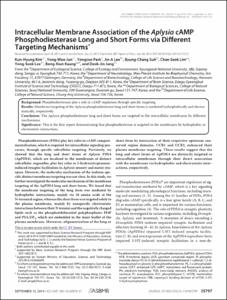Intracellular Membrane Association of the Aplysia cAMP Phosphodiesterase Long and Short Forms via Different Targeting Mechanisms
- Title
- Intracellular Membrane Association of the Aplysia cAMP Phosphodiesterase Long and Short Forms via Different Targeting Mechanisms
- Author(s)
- Kim, Kun-Hyung ; Jun, Yong-Woo ; Park, Yongsoo ; Lee, Jin-A ; Suh, Byung-Chang ; Lim, Chae-Seok ; Lee, Yong-Seok ; Kaang, Bong-Kiun ; Jang, Deok-Jin
- Issued Date
- 2014-09
- Citation
- Journal of Biological Chemistry, v.289, no.37, pp.25797 - 25811
- Type
- Article
- Keywords
- PLECKSTRIN HOMOLOGY DOMAIN ; TERMINAL SPLICE REGION ; PLASMA-MEMBRANE ; PHOSPHATIDYLINOSITOL 4,5-BISPHOSPHATE ; DROSOPHILA-MELANOGASTER ; ELECTROSTATIC SWITCH ; HIGH-AFFINITY ; LOCALIZATION ; UNIQUE ; MEMORY
- ISSN
- 0021-9258
- Abstract
-
Phosphodiesterases (PDEs) play key roles in cAMP compartmentalization, which is required for intracellular signaling processes, through specific subcellular targeting. Previously, we showed that the long and short forms of Aplysia PDE4 (ApPDE4), which are localized to the membranes of distinct subcellular organelles, play key roles in 5-hydroxytryptamineinduced synaptic facilitation in Aplysia sensory and motor synapses. However, the molecular mechanism of the isoform-specific distinct membrane targeting was not clear. In this study, we further investigated the molecular mechanism of the membrane targeting of the ApPDE4 long and short forms. We found that the membrane targeting of the long form was mediated by hydrophobic interactions, mainly via 16 amino acids at the N-terminal region, whereas the short form was targeted solely to the plasma membrane, mainly by nonspecific electrostatic interactions between theirNtermini and the negatively charged lipids such as the phosphatidylinositol polyphosphates PI4P and PI(4,5)P
2 , which are embedded in the inner leaflet of the plasma membrane. Moreover, oligomerization of the long or short form by interaction of their respective upstream conserved region domains, UCR1 and UCR2, enhanced their plasma membrane targeting. These results suggest that the long and short forms of ApPDE4 are distinctly targeted to intracellular membranes through their direct association with the membranes via hydrophobic and electrostatic interactions, respectively. © 2014 by The American Society for Biochemistry and Molecular Biology, Inc.
- Publisher
- American Society for Biochemistry and Molecular Biology Inc.
- Related Researcher
-
-
Suh, Byung-Chang
- Research Interests Molecular mechanisms of epilepsy and sensory pain transmission; Signaling mechanism of ion channel regulation and membrane excitability; 분자전기생리; 간질 및 통증의 분자적 기전 연구
-
- Files in This Item:
-
 기타 데이터 / 3.55 MB / Adobe PDF
download
기타 데이터 / 3.55 MB / Adobe PDF
download
- Appears in Collections:
- Department of Brain Sciences Laboratory of Brain Signal and Synapse Research 1. Journal Articles



